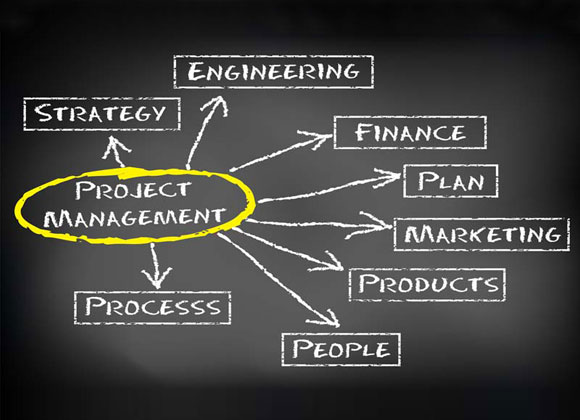Given the high rate of project failures, you might think that companies would be happy to just have their projects finish with some degree of success. That’s not the case. Despite the odds, organisations expect projects to be completed faster, cheaper, and better. The only way that these objectives can be met is through the use of effective project management processes and techniques. This list outlines the major phases of managing a project and discusses key steps for each one.
Step 1: Plan the work by utilising a project definition document
The time spent properly planning the project will result in reduced cost and duration and increased quality over the life of the project. The project definition is the primary deliverable from the planning process and describes all aspects of the project at a high level. The project definition should include the following:
- Project Overview
- Project Objectives
- Project Scope
- Assumptions and risks
- Approach
- Project Organisation
- Initial cost, and duration estimates
Step 2: Explain the project plan to key stakeholders and discuss its key components
The project plan is a set of living documents that can be expected to change over the life of the project. It provides the direction for the project and the project manager needs to set the course for the project and communicate that with the key stakeholders. The project manager may need to correct the project course as well.
Step 3: Define roles and responsibilities
Everyone may play a different role in a project. The roles and responsibilities are to be clearly defined in the project plan. Some of the key players are:
- Project sponsor, who owns and funds the entire project.
- Business experts, who will define their requirements for the end product.
- Project manager, who creates, executes, and controls the project plan.
- Project team, who build the end product.
- End users, who use the end product.
- Others, such as auditors, quality and risk analysts, procurement specialists, and so on may also participate on the project.
Step 4: Manage Project Resources and Encourage Team Working
A typical project involves lots of people, including end-users or customer staff; technical staff; administrative and financial staff; consultants; contractors; suppliers; external advisors and outside agencies. The attendant relationships create additional dependencies and risks that you need to manage. When you also consider the need to manage cost; provide hardware, plant and machinery; deal with industrial relations; manage process change and train staff, it is clear that resource management is quite a challenge. Therefore, there is a clear need for a skilled project manager and for an effective team, working together and committed to the project.
Step 5: Create a detailed work plan
After the project definition has been prepared, the work plan can be created. The work plan provides step-by-step instructions for constructing project deliverables and managing the project. You should use a prior work plan from a similar project as a model if one exists. If not, build one the old-fashioned way by utilising a work-breakdown structure and network diagram. Create a detailed work plan, including assigning resources and estimating the work as far out as you feel comfortable.
Step 6: Manage the work plan and monitor the schedule and budget
Once the project has been planned sufficiently, execution of the work can begin. In theory, since you already have agreement on your project definition and since your work plan and project management procedures are in place, the only challenge is to execute your plans and processes correctly. Of course, no project ever proceeds entirely as it was estimated and planned. The challenge is having the rigour and discipline needed to apply your project management skills correctly and proactively.
Step 7: Manage Suppliers and External Sub-contractors
Modern complex projects usually involve suppliers, sub-contractors, consultants and other external resources. They create further dependencies and risks. Base agreements with suppliers and other external parties on clearly specified requirements that identify the performance standards expected and the products or systems to be designed, developed, and delivered. Meet suppliers and external parties regularly to ensure that they are performing as expected. Remember that your external resources may, in turn, depend on their suppliers and sub-contractors so be clear about whose responsibility it is to manage these dependencies and keep an eye on the performance of sub-contractors.
Step 8: Look for warning signs
Look for signs that the project may be in trouble. These could include the following:
- A small variance in schedule or budget starts to get bigger, especially early in the project. There is a tendency to think you can make it up, but this is a warning.
- You discover that activities you think have already been completed are still being worked on.
- You need to rely on unscheduled overtime to hit the deadlines, especially early in the project.
- Team morale starts to decline.
- The deliverable quality or service quality starts to deteriorate.
- Quality-control steps, testing activities, and project management time starts to be cut back from the original schedule. A
If these situations occur, raise visibility through risk management, and put together a plan to proactively ensure that the project stays on track. If you cannot successfully manage through the problems, raise an issue.
Step 9: Analyse project quality and risks
Creating the Quality Plan involves setting the standards, acceptance criteria, and metrics that will be used throughout the project. The plan, then, becomes the foundation for all the quality reviews and inspections performed during the project and is used throughout project execution.
Analysing risks includes making a determination of both the probability that a specific event may occur and if it does, assessing its impact. The quantification of both the probability and impact will lead to determining which the highest risks are.
Step 10: Manage Communications
Maintain good communications within the project team and with the wider group of stakeholders and affected groups. The team must not become isolated from the rest of the business environment or from the ultimate customer and users. If it does, the project might run the risk that users will not accept the final system or product. Good communications are particularly important towards the end of a project to ensure that the users or customers are prepared for the implementation and for using the new system or facility.
How CBIS can help you
Please contact us if you need more details on our training and consulting services and how our expert team can assist to manage your Lean and Six Sigma projects successfully.
Attending our Public classroom physically or joining the team virtually from anywhere, according to the training calendar.
A flexible self-paced training for busy people along with our support by a dedicated coach, to solve the disadvantage of one-way online training
Delivering flexible and tailored training for your team and at your premises as a cost-effective solution for your team.


